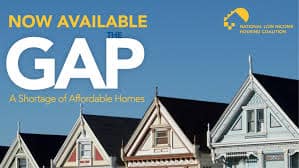
“The Gap: A Shortage of Affordable Homes,” a new report released March 18, by the National Low Income Housing Coalition (NLIHC), finds a national shortage of nearly 7 million affordable and available rental homes for extremely low-income (ELI) renter households, those with incomes at or below the poverty level or 30% of their Area Median Income (AMI). Nationally, there are just 37 affordable and available rental homes for every 100 ELI renter household, and 70% of the poorest renter households are severely cost burdened, spending more than half of their income on housing expenses, with little left over for other basic necessities.
No state or metropolitan area in the nation has an adequate supply of affordable and available rental homes for the lowest-income families.
In Vermont, there is a greater percentage of affordable and available rental homes for extremely low-income households than the national average, but the state still faces a severe affordable housing shortage, which impacts families with the lowest incomes most acutely.
In Vermont, there are 18,813 extremely low-income households, but only 9,200 affordable rental units available to them. As a result, there are only 49 affordable and available rentals for every 100 extremely low-income households. While this is a slight improvement from the previous year, the supply of affordable housing is meeting less than half the need for extremely low-income renters. Approximately 64% of extremely low-income households in Vermont are severely cost-burdened and at risk of homelessness.
Furthermore, this data was collected prior to the Covid-19 crisis, and the pandemic has since exacerbated challenges facing low-income households. The report shows that even before Covid-19 devastated many low-income households, they were already struggling to afford their rent.
“We’ve long known that Vermont is facing a severe shortage of affordable housing,” said Brian Pine, interim coordinator of the Vermont Affordable Housing Coalition. “With an aging rental housing stock and increased pressure on the housing market due to the pandemic, our partners face challenges in helping low-income families secure housing, even when they have rental subsidies. There often simply is no affordable, available housing that meets safety and quality standards.”
Even if rents fall during an economic downturn, they will not fall sufficiently to provide ELI renters with an adequate supply of affordable housing.
Because the market consistently fails to provide adequate, affordable housing for ELI, the government has an essential role to play to correct for this failure.
Solutions
Gus Seelig, executive director of the Vermont Housing & Conservation Board said, “Vermont is experiencing significant increases in real estate values, pricing too many Vermonters out of the market. With the arrival of federal Covid relief funding in 2020, Vermont was able to address both the immediate need to keep those without homes safe and the underlying shortage of housing by adding 250 new affordable homes and improving 12 shelters with 250 beds. It is imperative that we continue this momentum into 2021. With additional federal recovery funds on the way, Vermont must capitalize on this opportunity to protect the health and safety of our most vulnerable households.”
The Emergency Rental Assistance in the latest federal stimulus package, along with the critical ongoing extension of Vermont’s statewide moratorium on evictions and the Governor’s proposed one-time increase in funding for the Vermont Housing and Conservation Board, will help considerably to keep precariously housed Vermonters from falling into homelessness due to the pandemic. As The Gap study shows, though, ending the long-term affordable housing crisis will require significant and sustained investments.
For more information, visit: nlihc.org/gap



